
During our stop in Tunis from the capital itself, we haven't seen very much. Our guide hurried us to the medina where he probably had some friends with shops !
The medina is found at the centre of the city, a dense agglomeration of alleys and covered passages, full of intense scents and colours, boisterous and active trade, and a surfeit of goods on offer ranging from leather to plastic, tin to the finest filigree, tourist souvenirs to the works of tiny crafts shops.
I prefered to look up at the architecture and not aside into the shops.
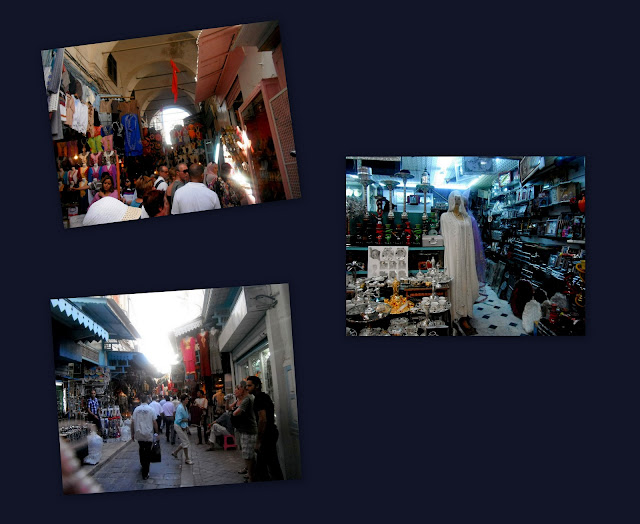
It was very crowded and hard to get through the small streets full of people.
I liked to discover special views like here a barber !
Unfortunately one of our group members was so intelligent to take all his papers, money and even his flight tickets into the crowded medina and of course a well trained pick pocket stole him everything ! I wonder how people can be so stupid, he could have left it in the secured coach ! Anyway he had to go to the police together with the driver as our guide lost his head again and didn't know what to do, and we all had to wait for 2 hours on a street in Tunis until everything was settled.
and that's all I saw, beautiful architecture, lots of people and a lot of traffic.
A little late, we finally arrived at the National Bardo Museum. Thousands of objects originating from excavations carried out all over the country during the 19th and 20th centuries are on display. These are divided into departments between fifty or so rooms and galleries, illustrating the various stages of Tunisia’s history, from prehistory to the middle of the last century.
Thanks to its collection of mosaics, the Bardo museum has gained an international reputation for the richest, the most varied and the most refined collection.
more about the museum here.
Unfortunately a big part of the museum was closed for renovation.
The entrance
From there on it was closed
Amazing mosaics
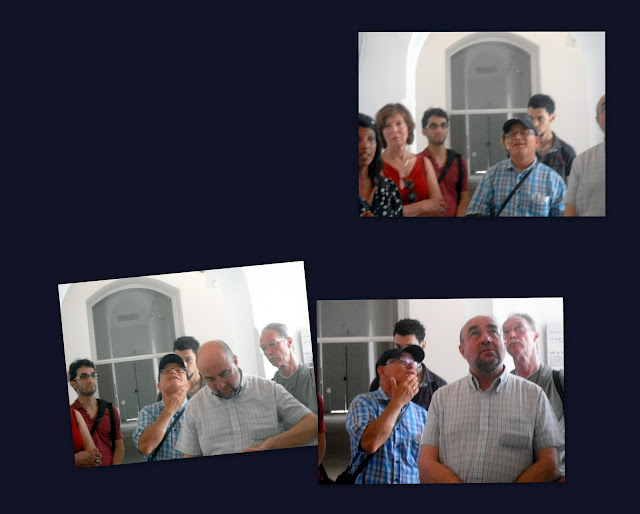
and our guide from the Tunisian Travel Service who as usual didn't know what to explain
Fortunately we had a guide from the museum a very good French/English speaking young woman.
In a corner I discovered this statue, waiting for the right place !
Beautiful mosaics
and a Roman baptismal font
Roman vases
After a while I had enough of the guide's long explanations and wandered around to take some other pictures. I met a young man and told him how sad it was that such a big part of the museum was closed.
He smiled and opened the part which was closed to the public and made me a sign to follow him. I didn't hesitate for a moment, I like things which are not allowed !
and so I had the chance to see new discovered statues, still wrapped
the statue of a pig from Roman times
a room which was already ready for visitors
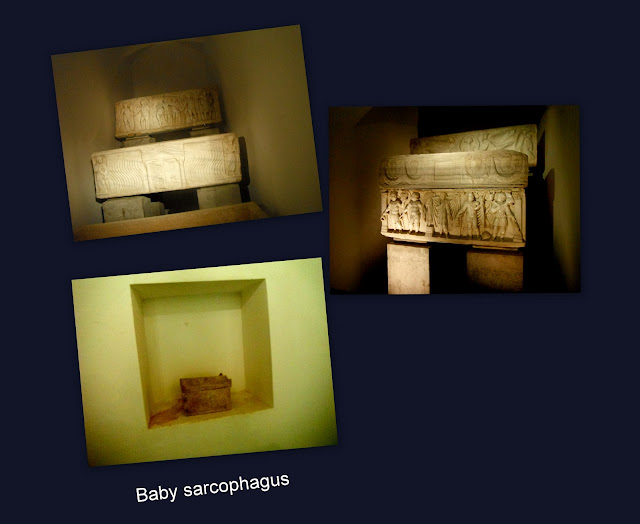
Sarcophagus and even a very tiny one for a baby
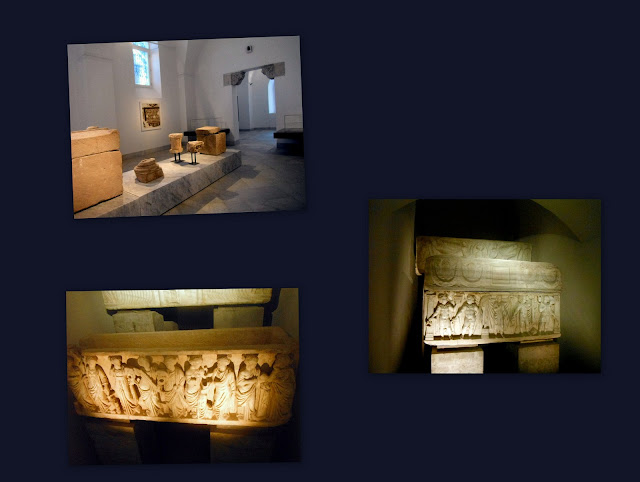
they all were beautifully sculptured.

From one window he showed me the view on the city residence of the President, and I could take these pictures through the grids.
Then we went back, I gave him 2 €, he was happy and me too and I joined our group again until the tour ended. I was quiet happy about my experience and the others were quiet jalous !
Tuesday, July 24, 2012
ROUND TRIP THROUGH TUNISIA 5 - Tunis, Bardo Museum
Posted by Gattina at Tuesday, July 24, 2012 10 comments
travel, vacation, Jordan, Egypt, Spain, Turkey, National Bardo museum, Tunis Medina
Sunday, July 22, 2012
SIDI BOU SAID - Tunisia
I had visited Sidi Bou Said in 1986 and remembered it as a beautiful sleeply little town with houses all in white and blue. People came there to admire the archtecture and walk through the little streets.
When we stopped in Sidi Bou Said, this time the town town itself had become a big tourist attraction full of stalls before you enter the town and full of shops in the town. All kinds of souvenirs (some not even remotely connected to Sidi Bou Said and sometimes not to Tunisia itself) can be bought in the main street. So for me it was quiet a disappointment. But for those who had never seen it before it is still worthwhile to walk through the little town. You can read more about the town here.
Little streets with houses all in white and blue.
We then visited an upper class house which was open for tourists and was still owned by the family. Nothing had changed except the Souvenir shop which had been added in one part of the courtyard !
view into the courtyard with a little well, still working
steps leading to the upper floors
Places to rest in the courtyard
a comfortable little corner to sit down
Tea was served by a family member
Beautiful decorated open fire
artful mosaic everywhere
The upper floor staircase leading to the courtyard
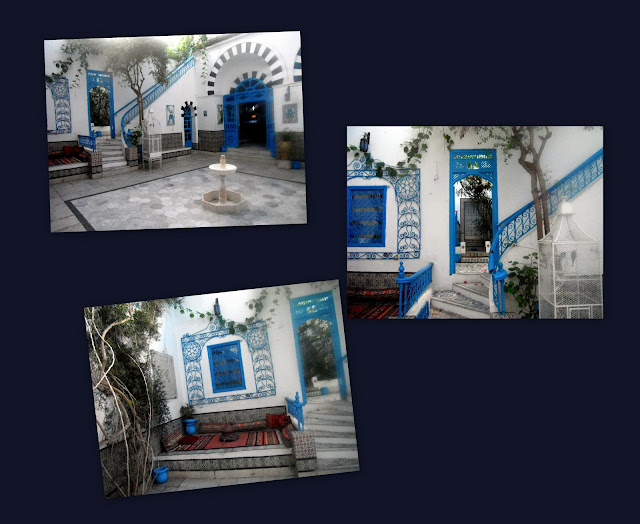
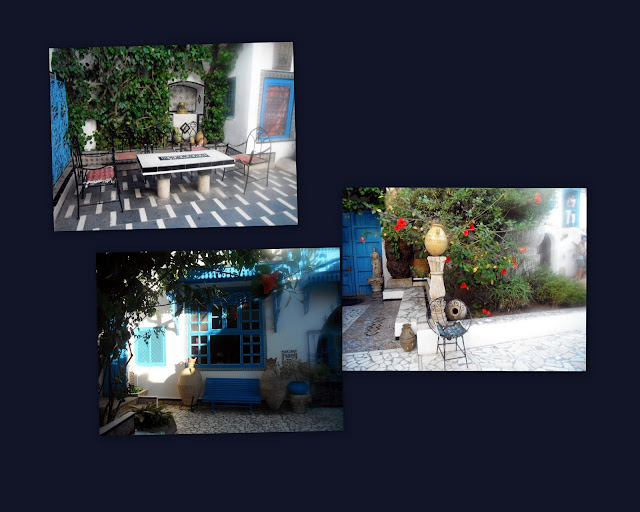
an overview of the courtyard
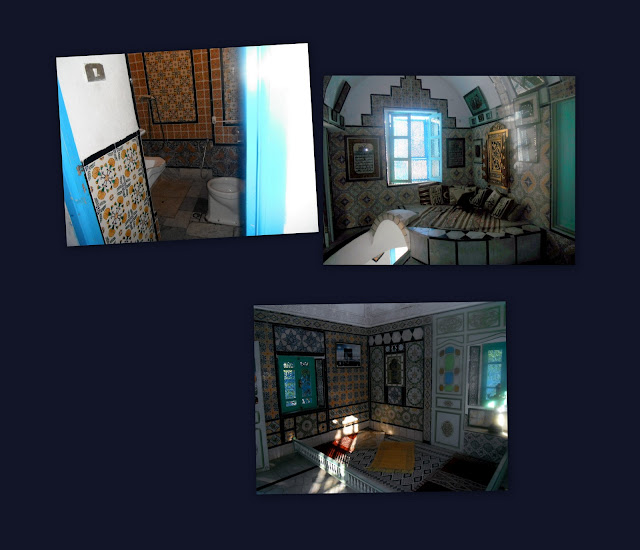
inside the house
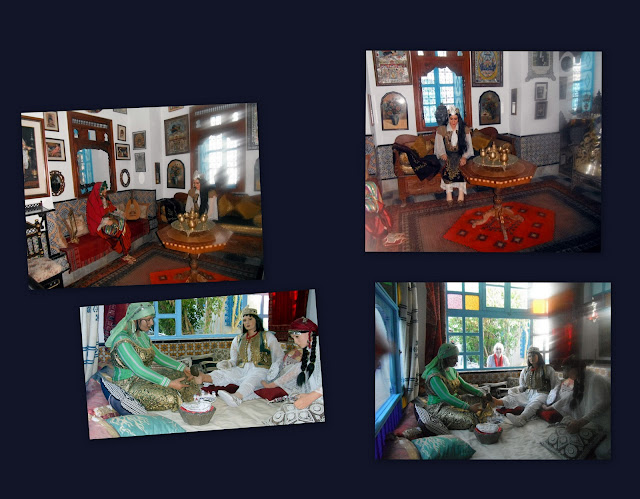
and how the rooms were used. The classical lady garments of the past centuries
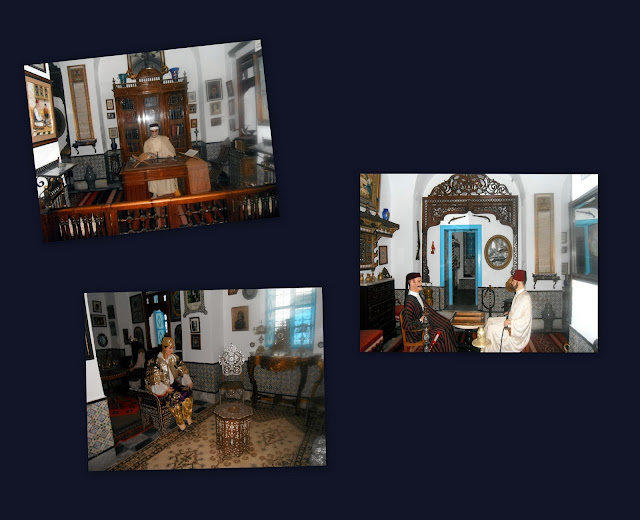
and the men.
It was such a nice house that I really wished to live in there !
and when we left a friendly Yasmin bouquet seller said "Good Bye"
July 22, 2012
Posted by Gattina at Sunday, July 22, 2012 3 comments
travel, vacation, Jordan, Egypt, Spain, Turkey, Sidi Bou Said, Tunisia
Tuesday, July 17, 2012
ROUND TRIP THROUGH TUNISIA 4 - Sbeitla, Kairouan

Our fist stop after Tozeur was 330 km (205 miles) later at Sbeitla.
Sbeitla is a small town in north-central Tunisia. Nearby are the Roman ruins of Sufetula, containing the best preserved Forum temples in Tunisia. More of Sbeitla here

The ruins were amazingly well preserved if you consider that they date from the year 300 !
The top of a column
and the remains of a baptismal font.
I noticed that wherever I go the Romains have been there before, even when I was on holidays in Egypt
We continued our trip direction Kairouan, the capital of the Kairouan Governorate in Tunisia. Referred to as the Islamic Cultural Capital, it is a UNESCO World Heritage site. The city was founded by the Arabs around 670. it became an important centre for Islamic and Quranic learning, and thus attracting a large number of Muslims from various parts of the world, next only to Mecca and Medina. The holy Mosque of Uqba is situated in the city. It is considered by many Muslims to be Islam's fourth holiest city. The holy Mosque of Uqba is situated in the city. (more about history here)


We just could take a glimpse inside, I didn't want to take pictures of the people who prayed. I don't like unrespectful tourists.
Again some of us were not dressed to visit a mosque which is also a church. They were asked to cover their shoulders and those in shorts had to wear a kaftan or a large scarf.
which gave this amazing fashion show.
After this short visit, of course in the afternoon heat, as our guide had mixed up the visits, we finally visited the the Barber's mosque which is a veneration place for a companion of the prophet Mohamed, who, according to a legend, had saved for himself three hairs of Mohamed's beard, hence the edifice's name. The sepulture place is accessed from a cloister-like court with richly decorated ceramics and stuccoes. History here Barbers Mosque

The inside court

with beautiful tiles and mosaics

The guardians room

and the room where the 3 beard hairs are kept. No guarantee, because our rather ignorant guide told us this.

I discovered a wedding in a corner of the enormous court yard and asked if I could take some pictures. The women were very friendly and invited me to take as many pictures as I wanted. The bride was surrounded by the female family members and friends,
Her head was covered, but that didn't bother the others, they just lifted the hood to give her a kiss. And I could take a picture of the bride. They even asked me to stay after the ceremony for the wedding feast ! Unfortunately I had to follow my group, to watch a boring carpet presentation !

While the bride waited, the notary prepared the wedding contract together with the family males, fathers, brothers and the groom ! It all was very relax !
We finished our visits with the Aghlabid Basins, that means we just jumped out of the bus to take pictures, and read later what it was. Because of the heat, our catastrophe guide was "out of work" forgot to explain and slept the rest of the trip peacefully with the microphone as pacifier in his mouth. The Tunisian Travel Service had made a big deal with him.

We saw the two basins called the Aghlabid Basins which were restored in 1969. These two pools (originally there were more) stored water for the Aghlabid palace which occupied the site of the present-day cemetery which we haven't seen. The water was brought by an aqueduct 36km/ 22mi away. The smaller basin was a settling tank, from which the water flowed into the larger one, which had a capacity of 50,000cu.m/11 million gallons. I don't know for what it is used now, as I suppose a cimetary doesn't need so much water.

Before we finally arrived exhausted in our hotel, we had to visit again a carpet shop (business is business) , which fortunately was very beautiful and I admired more the architecture than the carpets. Here again, we were offered tea and air conditionning !
The day ended with a nice supper in a beautiful hotel.
Posted by Gattina at Tuesday, July 17, 2012 7 comments
travel, vacation, Jordan, Egypt, Spain, Turkey, Aghlabid Basins, Barber's Mosque, Kairouan, My World, Sbeitla, Tunisia, Tunisian Travel Service, wedding




